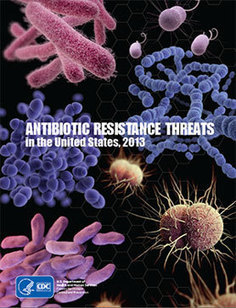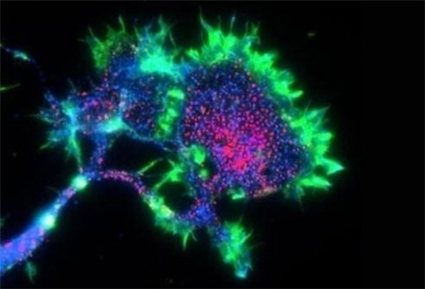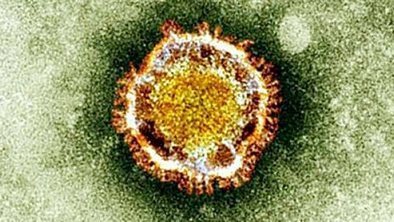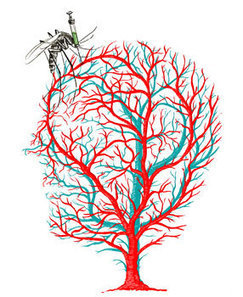 Your new post is loading...
 Your new post is loading...
A few years ago, I started looking online to fill in chapters of my family history that no one had ever spoken of.
"Superbug" bacterial infections that are resistant to common antibiotics are increasing at an alarming rate. But traditional antibiotics aren't the only way to battle dangerous germs. Biomedical scientists are investigating new additions to their arsenal.
When it comes to our immune response, genetics takes a back seat to pathogens.
Evidence from skulls in east London shows plague had to have been airborne to spread so quickly
Trophic cascade effects occur when a food web is disrupted by loss or significant reduction of one or more of its members. In East African Rift Valley lakes, the Lesser Flamingo is on top of a short food chain. At irregular intervals, the dominance of their most important food source, the cyanobacterium Arthrospira fusiformis, is interrupted. Bacteriophages are known as potentially controlling photoautotrophic bacterioplankton. In Lake Nakuru (Kenya), we found the highest abundance of suspended viruses ever recorded in a natural aquatic system. We document that cyanophage infection and the related breakdown of A. fusiformis biomass led to a dramatic reduction in flamingo abundance. This documents that virus infection at the very base of a food chain can affect, in a bottom-up cascade, the distribution of end consumers. We anticipate this as an important example for virus-mediated cascading effects, potentially occurring also in various other aquatic food webs.
Via Ed Rybicki
The global spread of epidemics, rumors, opinions, and innovations are complex, network-driven dynamic processes. The combined multiscale nature and intrinsic heterogeneity of the underlying networks make it difficult to develop an intuitive understanding of these processes, to distinguish relevant from peripheral factors, to predict their time course, and to locate their origin. However, we show that complex spatiotemporal patterns can be reduced to surprisingly simple, homogeneous wave propagation patterns, if conventional geographic distance is replaced by a probabilistically motivated effective distance. In the context of global, air-traffic–mediated epidemics, we show that effective distance reliably predicts disease arrival times. Even if epidemiological parameters are unknown, the method can still deliver relative arrival times. The approach can also identify the spatial origin of spreading processes and successfully be applied to data of the worldwide 2009 H1N1 influenza pandemic and 2003 SARS epidemic. The Hidden Geometry of Complex, Network-Driven Contagion Phenomena
Dirk Brockmann, Dirk Helbing Science 13 December 2013:
Vol. 342 no. 6164 pp. 1337-1342
http://dx.doi.org/10.1126/science.1245200
Via Complexity Digest
A few years ago, I started looking online to fill in chapters of my family history that no one had ever spoken of.
This report, Antibiotic resistance threats in the United States, 2013gives a first-ever snapshot of the burden and threats posed by the antibiotic-resistant germs having the most impact on human health. Each year in the United States, at least 2 million people become infected with bacteria that are resistant to antibiotics and at least 23,000 people die each year as a direct result of these infections. Many more people die from other conditions that were complicated by an antibiotic-resistant infection.
Researchers have reported the first case of human-to-human transmission of the new bird flu that has emerged in China.
Google Inc launched an open data platform yesterday to share information on natural disasters in Taiwan such as typhoons and floods, with the aim of building the country into a model area for the cloud computing-based system.
Since February 2013, China experienced an outbreak of the novel H7N9 avian flu, causing 131 cases of infection, and a death toll of 39. his particular H7N9 strain is considered to be one of the most worrisome pathogens since the H5N1 pandemic in 1997; a reputation based on the virus’ ability to spread easily across species and to infect humans
A man has died of the novel coronavirus (NCoV) in Tunisia, in what is believed to be the first such case in Africa.
Networks are commonly used to define underlying interaction structures where infections, information, or other quantities may spread. Although the standard approach has been to aggregate all links into a static structure, some studies have shown that the time order in which the links are established may alter the dynamics of spreading. In this paper, we study the impact of the time ordering in the limits of flow on various empirical temporal networks. By using a random walk dynamics, we estimate the flow on links and convert the original undirected network (temporal and static) into a directed flow network. We then introduce the concept of flow motifs and quantify the divergence in the representativity of motifs when using the temporal and static frameworks. We find that the regularity of contacts and persistence of vertices (common in email communication and face-to-face interactions) result on little differences in the limits of flow for both frameworks. On the other hand, in the case of communication within a dating site and of a sexual network, the flow between vertices changes significantly in the temporal framework such that the static approximation poorly represents the structure of contacts. We have also observed that cliques with 3 and 4 vertices containing only low-flow links are more represented than the same cliques with all high-flow links. The representativity of these low-flow cliques is higher in the temporal framework. Our results suggest that the flow between vertices connected in cliques depend on the topological context in which they are placed and in the time sequence in which the links are established. The structure of the clique alone does not completely characterize the potential of flow between the vertices. Flow motifs reveal limitations of the static framework to represent human interactions Luis E. C. Rocha and Vincent D. Blondel Phys. Rev. E 87, 042814 (2013) http://dx.doi.org/10.1103/PhysRevE.87.042814
Via Complexity Digest
|
New WHO report provides the most comprehensive picture of antibiotic resistance to date, with data from 114 countries
In Western Tanzania tribes of wandering foragers called Hadza eat a diet of roots, berries, and game. According to a new study, their guts are home to a microbial community unlike anything that's been seen before in a modern human population -- providing, perhaps, a snapshot of what the human gut microbiome looked like before our ancestors figured out how to farm about 12,000 years ago.
Digital volunteers are racing to map regions in West Africa where the Ebola virus, which has a 90 percent fatality rate, continues to spread
A food poisoning bacterium may be implicated in MS, say US researchers.
A painful mosquito-borne disease is spotted in the Western Hemisphere for first time, boosting U.S. risk. Given a choice between dengue fever or another mosquito-borne disease called chikungunya fever, choose dengue every time. Neither has an available vaccine or treatment, but chikungunya (pronounced chik-un-GUHN-ya) is far more severe – it literally means “that which bends up” because patients are often stooped over from debilitating joint pain. If you’re a resident of the Caribbean island of St. Martin (or lucky enough to be traveling there for the holidays) you are now at risk of both. The island, roughly the size of Manhattan and located some 300 kilometers east of Puerto Rico, has the first confirmed outbreak of chikungunya in the Western Hemisphere.
Via Ed Rybicki
The dynamics of economies and infectious disease are inexorably linked: economic well-being influences health (sanitation, nutrition, treatment capacity, etc.) and health influences economic well-being (labor productivity lost to sickness and disease). Often societies are locked into ``poverty traps'' of poor health and poor economy. Here, using a simplified coupled disease-economic model with endogenous capital growth we demonstrate the formation of poverty traps, as well as ways to escape them. We suggest two possible mechanisms of escape both motivated by empirical data: one, through an influx of capital (development aid), and another through changing the percentage of GDP spent on healthcare. We find that a large influx of capital is successful in escaping the poverty trap, but increasing health spending alone is not. Our results demonstrate that escape from a poverty trap may be possible, and carry important policy implications in the world-wide distribution of aid and within-country healthcare spending. Escaping the poverty trap: modeling the interplay between economic growth and the ecology of infectious disease
Georg M. Goerg, Oscar Patterson-Lomba, Laurent Hébert-Dufresne, Benjamin M. Althouse http://arxiv.org/abs/1311.4079
Via Complexity Digest, Eugene Ch'ng
Key features of Alzheimer's, which affects about 5 million Americans, are wholesale loss of synapses -- contact points via which nerve cells relay signals to one another -- and a parallel deterioration in brain function, notably in the ability to remember. Now research by Carla Shatz, PhD, professor of neurobiology and of biology and senior author of a study that will be published Sept. 20 in Science,, suggests that Alzheimer's disease starts to manifest long before plaque formation becomes evident
A malaria vaccine has shown promising results in early stage clinical trials, according to researchers.
The new Mers virus, which has killed half of those infected, is "unlikely" to reach the same scale as Sars, ministers in Saudi Arabia say.
Standford Medicine Summer 2013 Special Report
There have been 131 cases of infection confirmed cases of H7N9 in mainland China with 39 deaths. A lack of information about the virus and its mode of transmission led to public concerns that H7N9 could be a pandemic waiting to happen.A map of avian influenza (H7N9) risk is now available. The map is comprised of bird migration patterns, and adding in estimations of poultry production and consumption, which are used to infer future risk and to advise on ways to prevent infection.
BackgroundOn March 30, 2013, a novel avian influenza A H7N9 virus that infects human beings was identified. This virus had been detected in six provinces and municipal cities in China as of April 18, 2013. We correlated genomic sequences from avian influenza viruses with ecological information and did phylogenetic and coalescent analyses to extrapolate the potential origins of the virus and possible routes of reassortment events.MethodsWe downloaded H7N9 virus genome sequences from the Global Initiative on Sharing Avian Influenza Data (GISAID) database and public sequences used from the Influenza Virus Resource. We constructed phylogenetic trees and did 1000 bootstrap replicates for each tree. Two rounds of phylogenetic analyses were done. We used at least 100 closely related sequences for each gene to infer the overall topology, removed suspicious sequences from the trees, and focused on the closest clades to the novel H7N9 viruses. We compared our tree topologies with those from a bayesian evolutionary analysis by sampling trees (BEAST) analysis. We used the bayesian Markov chain Monte Carlo method to jointly estimate phylogenies, divergence times, and other evolutionary parameters for all eight gene fragments. We used sequence alignment and homology-modelling methods to study specific mutations regarding phenotypes, specifically addressing the human receptor binding properties.FindingsThe novel avian influenza A H7N9 virus originated from multiple reassortment events. The HA gene might have originated from avian influenza viruses of duck origin, and the NA gene might have transferred from migratory birds infected with avian influenza viruses along the east Asian flyway. The six internal genes of this virus probably originated from two different groups of H9N2 avian influenza viruses, which were isolated from chickens. Detailed analyses also showed that ducks and chickens probably acted as the intermediate hosts leading to the emergence of this virulent H7N9 virus. Genotypic and potential phenotypic differences imply that the isolates causing this outbreak form two separate subclades.InterpretationThe novel avian influenza A H7N9 virus might have evolved from at least four origins. Diversity among isolates implies that the H7N9 virus has evolved into at least two different lineages. Unknown intermediate hosts involved might be implicated, extensive global surveillance is needed, and domestic-poultry-to-person transmission should be closely watched in the future.FundingChina Ministry of Science and Technology Project 973, National Natural Science Foundation of China, China Health and Family Planning Commission, Chinese Academy of Sciences.
|
 Your new post is loading...
Your new post is loading...
 Your new post is loading...
Your new post is loading...





























It seems that we are about to get closer to death, as our antibiotics, pesticides, herbicides and all other methods of cheating death, disease and crop failure fail.
This is before we get into conversations about the looming international and intranational conflicts that are simmering beneath the surface. At least these can be dealt with with sensible policy changes and changes in attitude, perspective and disposition, if not out right content in our leadership cadres.
But alas, I don't see that happening in the foreseeable future.
Time is ticking away.
And we too will go through an indiscriminate die off phase where friends and family will die off, along with enemies and pestilential people as well.
I'd like to think that we'd come off better than before.
But, that's the thing about these indiscriminate methods of killing large swaths of the population. It very rarely yields anything other than what was already present.
At least wages should be better, due to the new shortage of laborers (assuming that robots haven't taken over our labor force in the meantime).
I'd like to think that our lot is constantly improving, even during these negative phases.
But, I know that it's not going to be easy, especially for most of our Western and American population who don't have experience handling these kinds of things.
Ah well.
Think about it.